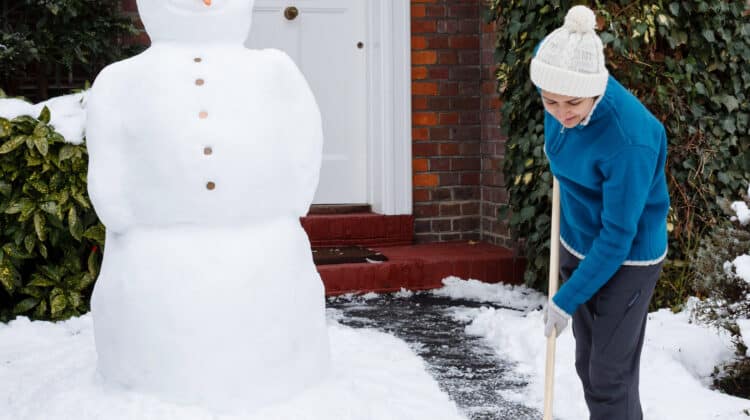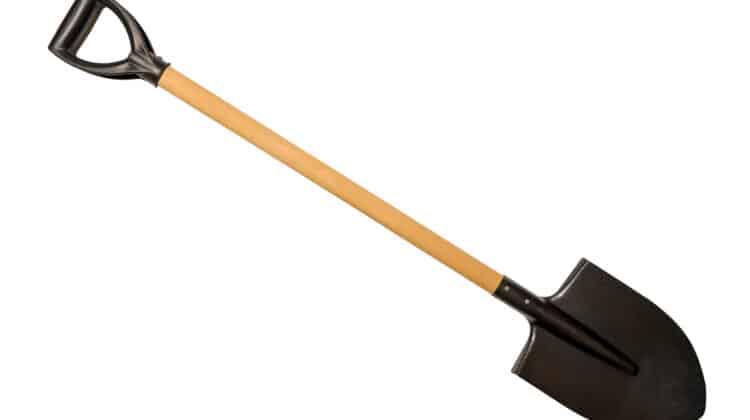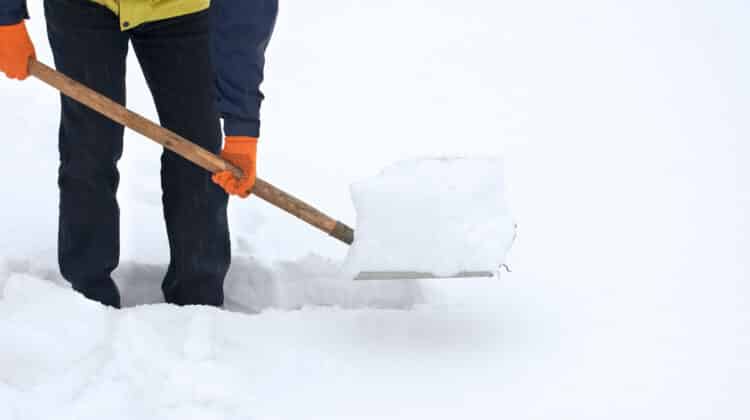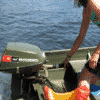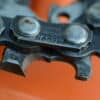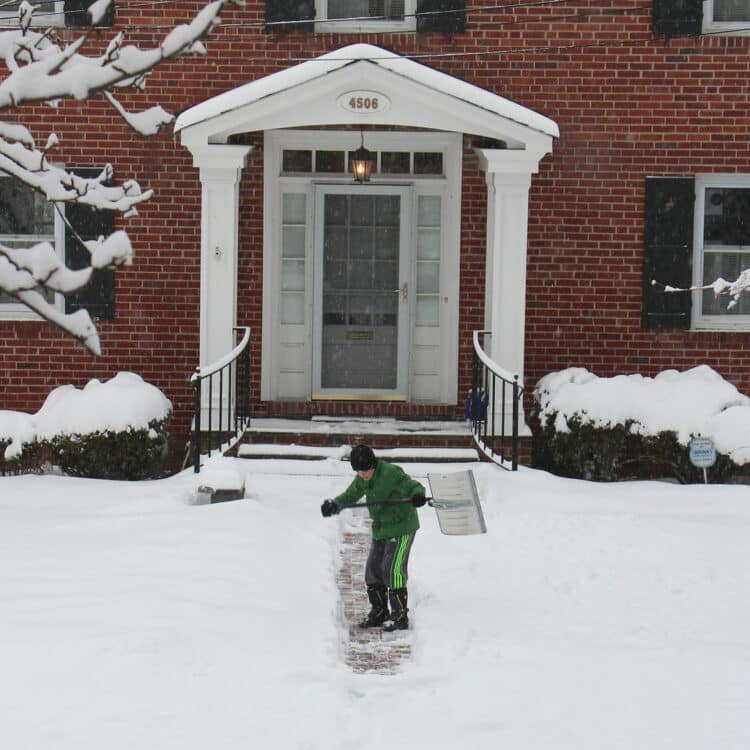
According to the Washington Post, 11,500 people visit the hospital after sustaining injuries while shoveling snow and 100 die from the complications per year. This study shows why following proper shoveling techniques is vital to ensure easy and safe snow blowing.
Snow shoveling is an easy affair with the right tools. Yet, having the right tools is not all it takes. Using the tools the right way and employing ice removal tips as laid down by experts is paramount for safe snow shoveling or snow blowing.
This article will highlight using an ergonomic snow shovel, also known as a snow park shovel, to clear snow from the driveway. We will also look at roof snow removal tips such as using a snowboard park rake.
But first, let us look at the planning and preparation required before you can achieve strategic shoveling and successful clearing of snow.
Table of Contents
Snowtime Removal Preparation and Planning
Before you can go out there and rid your car, roof, and driveway of snow, you need to prepare your tools for the job ahead. You also need to prepare your body to face the adverse cold conditions as you work through the snow.
These preparations include:
- Warm up your body-flexing and stretching your limbs helps to relax your muscles. This is necessary to avoid muscle pulls and joint injuries
- Wear protective gear such as a face shield, gloves, overalls, and boots. Protective equipment protects your eyes, ears, and limbs from the ice-old snow particles
- Dress in layers to protect your body against cold and damp conditions. Warm clothing prevents your fingers and toes from going numb, which could render your shoveling inefficient
- Spray anti-stick substance on both sides of your shovel blade, such as vegetable oil, cooking spray, or snowplow wax. These products prevent snow from sticking onto the edge. Having snow stuck on the blade can slow down your productivity, making you use more time to clear snow from a surface
Factors to consider when selecting a Snow park shovel
Choosing the right shovel goes a long way in making your snow clearing easy and effortless. Consider the following factors when buying a suitable shovel.
Weight
Choosing the right weight is crucial for the efficiency of a snow park shovel. This is because the effort you will use to lift the shovel when loaded depends on its weight. Light shovels are generally efficient than heavy types. However, if the snowfall is heavy, choose a heavier shovel as it will scoop more load. For example, high snowbanks need a snow shovel of up to 6.5lbs.
Type of handle
Shovels come in different handles; For instance, there are those with a single handle while others have three handles. Choose a handle that feels gentle on your hands and if you prefer the one with several handles, go for it.
The length of the shovel
Snow park shovels come in different lengths. A good shovel should reach your chest. A shorter distance will force you to bend more to balance the weight of the snow load. The upside to having a shorter shovel is it has more stability when moving a load from point A to point B.
You should select a shovel that balances the amount of bending needed with the stability of moving the load. A good shovel should be the height of your elbow when you push the blade onto the ground.
How to shovel snow without hurting back
One of the primary injuries associated with snow shoveling is back pain. To avoid hurting your back, use the following ice removal tips:
- Keep your feet wide apart with the front foot near the place the shovels hit the ground to scoop the load
- Use your front foot to push the shovel deeper to scoop your preferred amount of snow
- When lifting the snow load, transfer the weight to your rear foot to support the throwing of load
- Shift both feet to the direction where you are throwing the scooped snow. Avoid twisting your body. Instead, turn the entire body towards the direction you want to throw the snow
- Ensure the shovel is near your body for effortless scooping and throwing. Failure to do so could cause strain to your arms and overstretch your back
- Alternate between the right and the left hand while lifting the load to balance the strain on both muscles
- Switch between the side holding the handle, alternating between having the palm on the upper side and the lower side of the handle
- If the snow depth is high, avoid scooping the whole depth in one scoop. This can cause excess pressure on the limbs or back, resulting in injury. Instead, scoop half the amount in one scoop, then take the rest in another round
Tips on how to clear a driveway of snow and ice
Work from Top to bottom
Clearing loads of snow can be cumbersome if you do not apply strategic shoveling. You will waste a lot of time and energy to clear one area then all of a sudden, the snow accumulates again. The best way to clear your driveway is by removing the snow on the car roof, windshield, body, and tires before proceeding to the driveway.
Refrain from using your back to shovel the snow
When it comes to activities that require you to bend, always ensure you use your legs to push the load. When clearing the snow on your driveway, maintain a straight posture. Bend only your knees to get a good grip of the shovel, exert pressure on the shovel, squat, and then lift the load.
Keep the load close to your body and ensure the throw distance is close enough to avoid overstretching your muscles.
Plan where you want to throw the snow beforehand
It would be such a boring and tiring task to transfer your snow load twice. When you move the snow, you realize the new site is not the best place to deposit the snow. To avoid double work, select the most appropriate area to move the snow.
You should also avoid throwing the snow in a place where the municipal snow blow may pass and blow the snow back to your driveway.
Prep your shovel for the task
To ensure a proper snow shoveling technique, apply snow blow wax, vegetable oil, or cooking spray to both sides of the shovel blade. The wax is available in a snow shovel shop near you, and you can buy the other two in a grocery store.
You apply these products to prevent snow from sticking to the blades. Continuous scrapping off of stuck snow from the blade is exhausting and can interfere with your productivity.
Work from the middle towards the ends of the driveway
Starting from the top of the driveway through the center to the base seems like the logical way to clear your driveway of snow. However, that is not the case. When you start from the top, you are already exhausted by the time you get to the base touching the street, and the shovel feels heavy.
This method makes you prone to injuries due to exhaustion. The best way to clear your driveway is to work from the center outwards. You could start from the middle towards one end, take a break, then come and pick from the center towards the other end.
Take breaks and rejuvenate
Shoveling snow is not an easy sport. Give yourself breaks of about 10 to 15 minutes to relax your limbs and regain stamina. Working without rest could cause quick burnouts. You end up getting exhausted with the work half done.
Burnouts could also derail your daily shoveling schedules. If you leave the snow lying there for prolonged periods, the ice could cause blockage of vents and other pathways around the house.
Take lots of water
Remember to carry adequate water to hydrate your body as you clear the snow. You could put bottled water in the car to drink during the breaks.
Add a pair of socks over your boots to avoid sliding over the snow
One of the causes of snow shoveling injuries is falling due to the slippery state of snow-covered surfaces. Wear an extra pair of socks over your boots or shoes to cut your chances of tripping over the ice. The woolen material exerts more friction than the boot material.
Spice up snow clearing process by teaming up with friends and children
Are you wondering how to blow your driveway in an exciting and hassle-free way? Snow clearing doesn’t have to be boring. Gather up your daughter, son, nephews, and nieces and make snowballs that you can roll away. This method applies to snow that is sticky. Powdery snow is hard to roll into a ball.
You could also team up with friends and neighbors to pull out strategic shoveling techniques. Teamwork makes clearing easy and fun. However, ensure you maintain a safe distance from the other person to avoid injuries.
Apart from using snow park shovels, what other techniques can I use to clean up snow from my driveway?
Using proper shoveling techniques is one of the longest-standing ways to keep the driveway clear from snow. Other snow removal methods are helpful. These include snow blowing and using de-icing products.
How to snow blow a gravel driveway
Snowblowers are motor-driven equipment that blows away snowflakes from a surface. Snow blowing is a suitable method of getting rid of accumulated ice. It is most convenient for heavy snowfall.
If your driveway is made of gravel, the snowblower might suck in the gravel alongside the snow. This could erode your driveway. The snowblower might trap pieces of gravel that could damage the equipment.
However, there are snow blowers made for such driveways. The machine blows the ice and leaves the gravel intact.
You could also use a regular snow blower with adjustable augers. Once you set the auger height to correspond with the height of snow, it will be easy to blow most of the snow without blowing the gravel.
De-Icing products used to clear snow from surfaces
If you are not in an apposition to use the snow park shovels for your driveway or roof, deicers are an excellent option to get rid of unwanted snow. These products include regular table salt, rock salt, calcium chloride, potassium chloride, and calcium magnesium acetate (CMA).
Using chemical deicers should be your last option because some have environmental drawbacks. Some like rock salt will erode rooftops and other surfaces. Others are ineffective below certain temperatures. Before you apply any deicer, ensure it is effective in the current temperatures.
Should I salt my driveway before it snows?
The decision to sprinkle salt on your driveway before the snow starts to fall depends on several factors.
Firstly, you have to understand the type of salt that will work for your driveway, depending on what material made the driveway. It would be best if you sprinkled rock salts before it snows. Some types of salts mix with the snow to form a hard-to-scoop slimy substance. Ask a de-icing expert to avoid worsening the snow cover.
Secondly, consider what makes your driveway before adding any salt. Some types of salt, for instance, table salt, are harsh and corrode the surfaces. Experts recommend calcium chloride for new driveways and rooftops since it is gentle.
Lastly, if you own pets, make sure the salt you are adding is safe when ingested. As you walk your dog, the pet picks particles of the salt with its paws. When the same dog touches its mouth with the paw, it can swallow the particles.
Similarly, you could harbor these slat particles in your footwear and carry them to the house. Indoor pets such as kittens can swallow the particles. Unsafe products can be detrimental to your pets.
Roof snow removal techniques
Ergonomic snow shovels and snow blowers are suitable for clearing snow from driveways and other parts around the house. For the roof, these two pieces of equipment are not effective. Instead, a snowboard park rake is the most appropriate tool for removing piles of snow from the roof.
Conclusion
Proper shoveling techniques ensure that you clear snow from the driveway and other sites around the house efficiently and safely. Clearing snowfall from any surface requires prior planning and preparation, stretching before starting the work, among other safe snow blowing tips. Snow blowing and using deicers such as rock salt and calcium chloride also help you clear snow from surfaces around the house.
